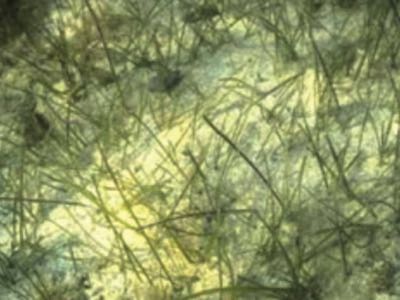Widgeon Grass
 Widgeon grass (Ruppia maritima) occurs throughout Chesapeake Bay, from the Bay mouth to the Susquehanna Flats. It is the dominant species in the middle Bay, and second in abundace to eelgrass in the Bay's higher salinity regions.
Widgeon grass (Ruppia maritima) occurs throughout Chesapeake Bay, from the Bay mouth to the Susquehanna Flats. It is the dominant species in the middle Bay, and second in abundace to eelgrass in the Bay's higher salinity regions.
Description
R. maritima is usually much less robust than eelgrass. Individual shoots are characterized by straight, threadlike leaves 3-10 centimeters long and 0.5 mm or less wide. It has an extensive root system of branched, creeping rhizomes that produce vertical shoots with leaves.
Salinity Range
R. maritima has a much broader salinity tolerance than eelgrass, with survival in salinities ranging from 0 to 70 ppt. It occurs throughout Chesapeake Bay, from freshwater to high salinity areas.
Reproduction & Growth
R. maritima can photosynthesize at higher temperatures than eelgrass and in the York River reaches maximum abundance in mid-summer, when it can develop into a tall, highly branched form with flowering shoots that extend to the water surface. Pollen released from the stamens floats on the water until it contacts the extended pistils. The fertilized flowers produce individual oval-shaped fruits with pointed tips enclosed in hard seed coats. The seeds may remain viable in the sediment for long periods. R. maritima can spread rapidly and in recent years has spread into many areas in the mid-bay where eelgrass has died off. In beds mixed with eelgrass it will initially spread more rapidly into propeller scars and other damaged areas. However, eelgrass can eventually replace widgeon grass if conditions favor the former.
Distribution
R. maritima is a widespread species, present throughout arctic, temperate, and tropical regions. It can grow as shallow as mean low water, and can also be found in shallow panes in bay marshes as well as shallow road-side ditches.
Benefits
R. maritima is a valuable food source for water fowl.
Threats
R. maritima is threatened locally by habitat loss from industrialization, agriculture, and reclamation of coastal land.
Visit the IUCN Widgeon Grass page for range maps, conservation status, and other details.
